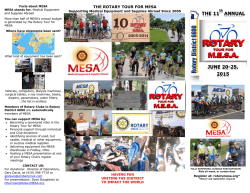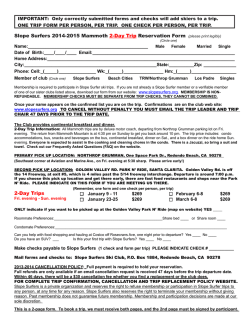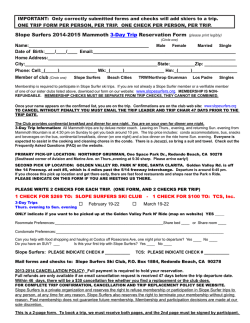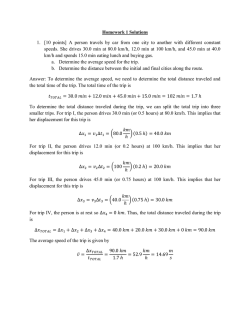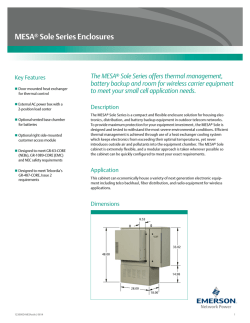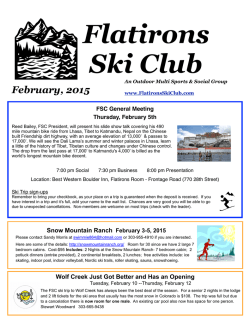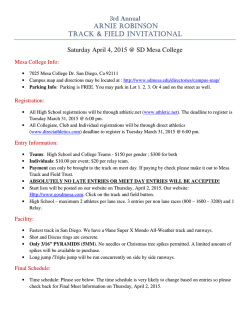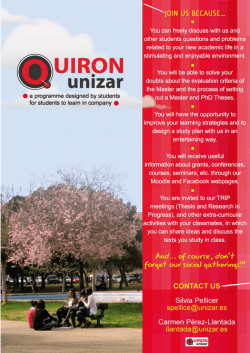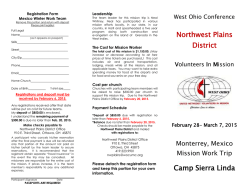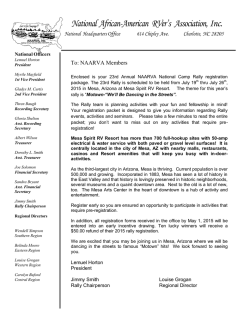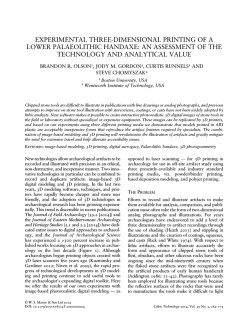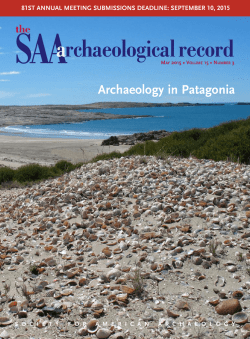
The Moki Messenger - San Juan Basin Archaeological Society
www.sjbas.org The Moki Messenger February 2015 February SJBAS Meeting Our next regular meeting will be held on Thursday, February 12th at 7:00 p.m. in the Lyceum at the Center of Southwest Studies. After a brief business meeting, Jason Chuipka will present “Navajo-Gallup Water Project Archaeology”. Jason Chuipka M.A. RPA is a principle investigator at PaleoWest Archaeology and heads the Farmington, NM office while serving as the Principal Investigator for the Navajo Gallup Water Supply Cultural Resources Project, the largest federal archaeology project in the U.S. He has 20 years of fieldwork experience and has been directing archaeological projects in Utah, New Mexico, and Colorado for more than a decade. An expert in the use of digital data collection methods, Jason continues to work with the PaleoWest team to streamline and improve the ways that archaeology fieldwork and reporting are conducted. Jason has authored numerous technical reports and regularly presents his findings at professional conferences. He has published articles in the Journal of Anthropological Archaeology and Kiva. Most recently, he co-authored contributions to volumes published by Cotsen Press at the University of California and the University of Arizona Press. January 8th SJBAS Meeting Notes Janice welcomed everyone, including a significant number of guests, and thanked Barb Hancock for volunteering to replace Diane Skinner as our new secretary and Jim Mueller for volunteering to replace Peggy Morris as a vice-president. She announced upcoming field trips to Puye Cliff Dwellings and the San Ildefonso Pueblo Feast Day, Mesa Verde Visitor Center and Anasazi Heritage Center behind the scenes tours, and the Cochise County Exploration. Mark Gebhardt reminded everyone to pay their annual dues and he encouraged guests to join the club. Peggy thanked everyone again for all the generous donations to the John W. Sanders Internship Fund. Tish Varney described the upcoming PAAC classes to be held in Dolores in February and in Durango in May. Janice announced the January 20th SJBAS board meeting and explained that SJBAS and the Center of Southwest Studies are co-sponsoring the CAS annual meeting and conference in Durango on October 10th and 11th. The keynote speaker will be Dr. Doug Owsley of the Smithsonian Institution on “Kennewick Man.” There will be many opportunities for SJBAS members to volunteer before and during the conference. Presentation by Judith Reynolds: Lost Cities Judith Reynolds, Durango writer, art historian, journalist, and a columnist, arts critic and political cartoonist for the Durango Herald, presented, “Lost Cities: Petra, Machu Picchu, and Mesa Verde, and a modern tragedy”. Reynold’s presentation dealt with issues of discovery, re-discovery, scientific discovery, archaeology, repatriation, and interpretation. Petra is a deserted ancient city in Jordan carved from sandstone cliffs. Although relatively isolated today, it was a strategic location on ancient caravan routes for hundreds of years. Now Petra is an important tourist destination in Jordan. It was established possibly as early as 312 BC by the Nabataean culture. Archaeologists believe that it was the ability of the Nabataeans to control the water supply that led to the rise of the desert city. It remained unknown to the Western World until 1812 when Swiss explorer, Johann L. Burckhardt, came across the deserted site during his exploration of the Middle East. The first scientific archaeological expedition took place in 1929. The site suffers from many threats, including the collapse of ancient structures, erosion due to flooding, surface erosion of the rock from weathering, improper restoration, and unsustainable tourism. In 1985 it was designated a World Heritage Site. In 1989 the Petra National Trust was established to promote the protection, conservation and preservation of the site. However, in 2007 it was included in the New Seven Wonders of the World, and has since been overrun by tourists. Machu Picchu was built in the 15th century by the Inca culture in the Andes Mountains in modern day Peru. It was abandoned a century later during the Spanish conquest. It was unknown to the Western world until Hiram Bingham III, a historian with Yale University, came across the site in 1911 during an expedition to find the lost city of Vitcos, the last capital of the Inca Empire. The site contains sacred, administrative, residential and agricultural elements. It was built in the classic Inca style with dry stacked, polished stone walls. Stones were cut to fit together perfectly without mortar. Bingham returned to Machu Picchu in 1912 with the sponsorship of Yale University and National Geographic and the backing of the Peruvian government to clear the site and begin preliminary excavations. Over the next three years, his team removed over 5,000 artifacts which were taken to a museum at Yale. These later became a significant source of dispute and most of these items were repatriated to Peru in 2012. Machu Picchu was declared a Peruvian Historical Sanctuary in 1981 and a World Heritage site in 1983. In 2007, Machu Picchu was also voted one of the New Seven Wonders of the World. Although the Wetherills are credited with discovering the cliff dwellings at Mesa Verde in 1988, Swedish mineralogist Gustaf Nordenskiold was the first one to bring the scientific method to excavations in 1891. Nordenskiold introduced scientific methods to artifact collection; he recorded locations, took extensive photographs, diagrammed sites, and correlated what he observed with existing archaeological literature. He removed approximately 610 artifacts and sent them to Sweden. This initiated concerns about the need to protect Mesa Verde and establish policies to keep artifacts from being removed. Terezin (small fortress) or Theresienstadt in German is an example of a modern tragedy. It began as a planned city in 1780 to be used as a military fortress and walled garrison in what is now the Czech Republic. In peacetime it held 5,500 people, but in wartime the population could be as high as 11,000. Following the Nazi occupation of Czech lands in 1939, the Gestapo set up a collection camp and transport center in the fortress. By the end of WWII over 150,000 adults and 15,000 children had passed through, most on their way to death camps such as Auschwitz. After the war, the fortress was used as an internment camp for ethnic Germans; in 1948 the last German prisoners were released and the camp was officially closed. The government retained a military garrison until 1996. The troops' departure and closing down of related operations had a negative effect on the local economy of the small town. Terezin is still trying to develop a more diverse economy and some people think its history can attract heritage tourism. In 2002, the fortress was listed as a Heritage Tourism site. Annual Membership Renewal If you have not yet paid your annual SJBAS dues, you’re late. Payments were due by January 31st. Please get your checkbook now, and write a check. If you already have signed Liability Waiver and Site Etiquette forms on file, you do NOT need to fill out these forms again. If you have new information such as a postal or email address change, you will need to complete a membership renewal form. All three forms may be found by following this link: http://www.sjbas.org/Application.pdf. Print and complete the form(s) you need, write a check to SJBAS for the appropriate amount, and mail it to our Chapter Treasurer, Mark Gebhardt, at 107 St. Andrews Circle, Durango, CO 81301. Annual dues are $23 for an individual with no Southwest Lore (SWL), $31 with SWL mailed; $30 for a family (two or more) with no SWL, $40 for a family with SWL mailed. Student memberships are $10. Donations to the John W. Sanders Internship Fund may also be made when you pay your membership dues. If you have any questions, please contact Mark at [email protected]. Puye Cliff Dwellings and San Ildefonso Feast Day Field Trip Report Lyle cancelled this field trip due to an approaching winter storm. As it turns out, Puye Cliff Dwellings actually closed the day of our scheduled visit due to the hazardous weather conditions. Upcoming Field Trips and Activities Our complete 2015 Field Trip Schedule is available on our website at www.sjbas.org/Trips.htm. Please check the website schedule periodically to check for trip updates and contact the trip leaders directly by phone or email for trip details and to sign up. February 12 SJBAS meeting - Jason Chuipka presents “Navajo-Gallup Water Project Archaeology”. February 26 Tour Mesa Verde Visitor Center and Anasazi Heritage Center This day trip includes a special tour of the new Visitor Center at Mesa Verde and a behind the scenes tour of the Anasazi Heritage Center, Behind the Scenes Tour. Trip participation limit is 12. For more information or to signup, contact trip leader Tish Varney at [email protected]. March 5 - 8 Exploring Cochise County – Arizona This is Gail and Marlo’s popular four or five-day trip in Southeast Arizona. Follow this link for the itinerary: Exploring Cochise County or see the write up below. Participants usually stay in a motel in the Sierra Vista area, and the trip participation limit is 20. For more information or to signup, contact trip leaders Gail and Marlo Schulz at [email protected] or 970-946-5234. March 12 April 9 April 11 - 12 SJBAS meeting - Ali Scotten presents “Iranian Archaeology”. SJBAS meeting Hovenweep N.M. and Montezuma Canyon – Utah On the first day of this two-day motel or camping trip, we will visit either the main Square Tower Complex or the outlier sites at Hovenweep National Monument, and rock art sites and the Three Kiva site in the Montezuma Creek Valley. We will spend the second day visiting surface sites, cliff dwellings, and rock art panels further north in the Montezuma Creek Valley. All of the walks are nearly level and less than ¼ mile long. Overnight options include a motel in Blanding or camping at Hovenweep. Trip participation limit is 16 with no more than 4 vehicles. For more information or to signup, contact trip leader Bob Powell at [email protected] or 970-385-8949 Cedar Mesa and Natural Bridges N.M. – Utah April 20 - 22 During this three-day camping or motel trip, we will visit ancestral Puebloan sites in Natural Bridges N.M. and in remote canyons on Cedar Mesa. The hiking will be moderately difficult with some off-trail hiking required; hikes may be up to seven miles long and include elevation changes of over 600 feet. 4WD/HC vehicles will be necessary, but carpooling will be arranged. We will camp in the dispersed BLM campground in Comb Wash, but participants may also stay in hotels in Blanding. The trip participation limit is 12. For more information or to signup, contact trip leaders Barb and Lyle Hancock at [email protected] or 970-764-4531. What to Expect… March Field Trip - Exploring Cochise County – Gail and Marlo Schulz This year's "Exploring Cochise County" trip begins on Thursday March 5th. Plan to arrive and check into your motel (we'll give you motel suggestions when you sign up) in early afternoon. We'll meet for an early dinner at 4:30 p.m. and then drive to Bisbee AZ to attend the 7:00 p.m. Westerner's meeting which will probably be on Lt. Bascom, who's rash actions are credited with starting the Apache wars with Cochise. Friday March 6th we will spend at the Coronado National Memorial on the border. We'll hear a presentation by Memorial historian and archaeologist Christopher Bentley on Coronado's 1540's expedition and the effects it had on the Native American populations encountered. We'll also learn the history of the Memorial and the geology of the park. In the afternoon we will have a ranger guided tour of Coronado Cave. We'll travel to Montezuma Pass in the park. This overlooks the AZ Trail and offers an expansive view into Mexico and the border just below the pass. Saturday March 7th we will have breakfast at the oldest continuously operating golf course in AZ, the Turquoise Valley Golf Club in Naco, with Becky Orozco, History and Anthropology Instructor, Cochise College and driving force behind the Naco Heritage Alliance. Becky will give us a presentation with photos, about the Mexican Revolution and the history of the border with Mexico in the Naco area, which lead to the formation of Camp Naco. Becky will guide us on a tour of Camp Naco and will relate more of the history of the town and the Camp. Some of us have joined Becky when she was with Geronimo Travel, on wonderful guided tours into Mexico to Mata Ortiz, Casas Grandes and Copper Canyon. In the afternoon we plan to visit Singing Winds Bookstore on a ranch just north of Benson AZ. This amazing bookstore in an old ranch house has the most complete collection of Southwestern history, reference and fiction possible. After dinner in Benson we will proceed to St. David AZ by 6:30 pm to attend the 1880's Historical Military Ball. Grand March is a 7:00 p.m. The ball continues until 10:00 p.m. and features many participants in authentic period costumes, both military and civilian. Costumes are not required to attend. Western dress is fine, but not required. Period refreshments, period dances and music are featured. Sunday March 8th we will travel to Colossal Cave Park just off I-10 west of Benson. We will visit the museums and learn the history of this old station and ranch. We will take a guided tour of Colossal Cave and learn about the cultures that used the Cave and this land. We will also participate in the special first Sunday program the park features (not sure who will present and what the subject will be yet). For those who may wish to spend another day in the area we will visit Kartchner Caverns. We will need paid advance reservations for one or both cave tours so this requires a bit of planning. We can hike in the park, which also features a lovely campground. If you have more time to spend in the area, we are happy to guide and/or provide suggestions of places to visit. Trip participation limit is 20. We will take names for a cancellation list if necessary. For more information or to sign up, please contact Gail Schulz at 970-946-5234 or [email protected]. We look forward to you joining us for a trip we are sure you will enjoy. New Members SJBAS would like to welcome new members Sue Agranoff, Susan Fischer, Mark Prouty, Kathleen Murphy, Marie Roessler, Tricia Winslow, Chris Maschino, and Rick Gordon. Arizona Adventures by Tish and Pete Varney December found us exploring archaeological sites in Arizona so we wanted to share our adventure that can take only a few days and is a relatively short distance away. The sites we visited were within a seventy-five mile radius of Flagstaff. The above ground masonry style in the majority of sites is Sinagua and it is different than the Chacoan masonry style we see in the Four Corners area. Sinagua literally means ‘without water’ in Spanish and the Ancestral Puebloans of that name moved into the area around Flagstaff about 1125. Some Sinagua migrated away from their pueblos by the early 1400s integrating into other pueblos, perhaps ancestral Hopi. These people were mainly farmers of corn, beans, squash and cotton, and developed water canals for irrigation and water conservation. They were hunters and gatherers as well. Many sites are found along the rivers and streams that flow through the Verde Valley. Our first stop was Petrified Forest National Park. It is not famous for its archaeological sites but rather paleontological fossils and colorful formations called the Painted Desert. However, according to park archaeologist, Dr. William Reitze, humans have been living and working in the area for the last 13,000 years. The park protects hundreds of significant sites and has recently expanded in area by over 13,000 acres. The most notable sites include the partially excavated Puerco Pueblo, 1250-1380 C.E. and Agate House, a seven room pueblo reconstructed with petrified wood blocks. Others are yet to be excavated and/or assessed on the newly acquired acreage. (See the SJBAS 2015 field trip list for plans to visit the Petrified Forest N.P. and areas around Winslow) Then, we traveled on to Flagstaff. It is a great central location to visit other fantastic sites in the area, so we opted to make it our base ‘camp’. One day trip included starting at the north end of Wupatki National Monument that adjoins the main north-south path of US 89. The access road travels past several sites and Sunset Crater N.M. (enjoy the view with a picnic lunch). We finished the day by turning south to Walnut Canyon N.M where we climbed down to visit the ‘island’ sites. Wupatki National Monument contains many sites scattered over a large area of desert northeast of Flagstaff. The pueblos all have a distinctive deep red color and were made from thin, flat blocks of the local Moenkopi sandstone. In total, there are more than 800 identified ruins spread around many miles of desert within Wupatki National Monument, but five of the largest (Wupatki, Wukoki, Lomaki, Citadel and Nalakihu) are close to the main road and these are the only sites open to visitors. Wupatki Pueblo (Hopi for 'big house') that was once home to 300 people and had over a hundred rooms. We were particularly intrigued by a natural blowhole nearby. This is a vent of unknown depth linked to underground passages in the sandstone, and either blows out or sucks in air, depending on the ambient pressure. Wukoki ruins, perhaps the most distinctive in the park as the house is built on an isolated block of sandstone, visible for several miles across the flat surroundings. The structure is quite tall, centered on a square, three story tower with a series of intricately-constructed rooms at one side. The bricks have a deep red color, and the building merges seamlessly with the underlying Moenkopi rock. Sunset Crater erupted in 1065 and neighboring craters are just one small part of the San Francisco volcanic field, part of a series of volcanic fields. The pine forests that grow on these slopes contrast with the surrounding Wupatki pueblo areas covered with volcanic cinders. South of I-40 just east of Flagstaff is the magical Walnut Canyon National Monument. The canyon is cut deeply by the Walnut River. Millennia of wind and water have carved the sinuous walls pockmarked with alcoves and overhangs. It is in this limestone upper section that early Sinagua Puebloans built their dwellings around an isthmus or ‘island’ protruding into the canyon and connected by a narrow land ‘bridge’. To reach the ‘island’ we descended via stairs and steep trail that can make the return trip a challenge for the lungs and legs. Another day trip takes you fifty miles south of Flagstaff along I-17 into the Verde Valley, which houses numerous national monuments and heritage sites. Among those is the V Bar V Heritage Site with its petroglyph wall and solstice marker - we missed seeing the dagger of light point to a stone by one day. Montezuma Castle and Well are fairly close, but not related. The well is really a sink hole that produces constant warm water laced with high levels of arsenic and carbon dioxide. Ancient dwellings hug the walls around the pool. A natural tunnel releases the water out to the Wet Beaver Creek, a tributary of the Verde River. As its name implies, Montezuma Castle is a multistory cliff dwelling built into a limestone cliff recess 100 feet above the valley floor where there are remnants of perhaps 50 rooms overlooking Beaver Creek. It is impressive in its defensibility and sheer engineering. Northwest of Montezuma Castle, the highway takes adventurers to additional archaeological and historic sites. Near the town of Cottonwood we found Tuzigoot National Monument. It looks like a medieval fortress crouched along the summit of a long ridge. Its name is Apache for ‘crooked water’. The pueblo with its 110 rooms commands a view of the surrounding area of marshes and contrasting desert. To the west a few miles is the historic mining town of Jerome, built on the flanks of the Mingus Mountain. The State Historic Park interprets the exciting mining history of the area. . The Heritage sites of Palatki Red Cliffs and Honanki located NE of Cottonwood of Hwy 89A or NW of Sedona require good road conditions to reach so we did not see them on this adventure. However, the lure of seeing cliff dwelling and rock art will undoubtedly give us a great reason to continue our explorations in the future! We think the Flagstaff area is certainly a treasure trove of exciting archaeological sites! Give yourself two or three days to enjoy what the area has to offer. Article by Tish Varney Photos by Pete Varney Life Long Learning Lecture Series Mark your calendars… Mark Varian, Research and Education Chair at the Crow Canyon Archaeological Center and a principal investigator for the Village Ecodynamics Project, will speak at the March 5th Life Long Learning program at Noble Hall, room 130, at Fort Lewis College, at 7:00 pm on "The Pueblo Indian Occupation of the Mesa Verde Region”. The Village Ecodynamics Project is a network of archaeologists, geologists, geographers, computer scientists and economists seeking to explain key aspects of the late prehistory of the northern Southwest through empirical research and modeling. Colorado Archaeological Society Annual Conference - October, 2015 SJBAS and the Center of Southwest Studies are co-sponsors of the annual conference of the Colorado Archaeological Society; it will be held at Fort Lewis College on October 10 - 11, 2015. Events and talks on Saturday, October 10th, will be in the FLC Ballroom. Dr. Doug Owsley of the Smithsonian Institution will be the dinner speaker on the topic of “Kennewick Man.” SJBAS, in partnership with Maria’s Bookshop, will have his book for sale. Dr. Owsley will autograph books that evening. On Sunday, October 11th, tentative plans may include a one-day version of the Program for Avocational Archaeology Certification (PAAC) class on archaeological practices or a site form workshop. Other events for the day include field trips and a speaker scheduled for that afternoon. More details will be provided as the program develops. Chimney Rock Management Plan News Release Chimney Rock plan news.pdf Mesa Verde Biking and Hiking, and Tram Service Mesa Verde Biking and Hiking.pdf; Mesa Verde Tram Service.pdf Celebrate Cedar Mesa – March 6 – 7 in Bluff, UT “Celebrate Cedar Mesa is our annual gathering of people who care about the Cedar Mesa area. If you’ve attended in the past, we’re planning to raise the bar even higher with a weekend of events that’s sure to intrigue anyone who loves the natural and cultural wonders in Bluff’s backyard. Events will include service projects, the documentary film premier of Waking the Mammoth at 7:00 Friday evening, slideshows, presentations, research updates, good food, music, dancing, hiking and more! Learn more and register at www.cedarmesafriends.org/celebrate.” Celebrate Cedar Mesa Poster.pdf Sustainable Lifeways – Cultural Persistence in an Ever-changing Environment Explaining the Structure and Timing of Formation of Pueblo I Villages in the Northern U.S. Southwest - 150 Timothy A. Kohler and Charles Reed Mitigating Environmental Risk in the U.S. Southwest - 180 Katherine A. Spielmann, Margaret Nelson, Scott Ingram, and Matthew A. Peeples http://village.anth.wsu.edu/sites/village.anth.wsu.edu/files/publications/KohlerReed%20from%20Miller%20Sustainable%20Lifeways%20%2711.pdf Kennewick Man article Kennewick Man article.pdf Mesa Verde – Ancestral Puebloans and Their World http://www.nps.gov/meve/forteachers/upload/ancestral_puebloans.pdf Localized Climate Change Contributed to Ancient Southwest Depopulation http://www.eurekalert.org/pub_releases/2014-12/wsu-lcc120214.php Archaeologists Worry as Drilling Approaches Chaco Canyon http://kunm.org/post/archaeologists-worry-drilling-approaches-chaco Planned Arizona Copper Mine Would Affect Apache Archaeological Sites http://news.sciencemag.org/archaeology/2014/12/planned-arizona-copper-mine-would-put-hole-apache-archaeology Hisatsinom Chapter Newsletters Hisatsinom Newsletter - January 2015.pdf Hisatsinom Newsletter - February 2015.pdf Lecture Opportunity (Cortez, CO) The Hisatsinom Chapter of the Colorado Archaeology Society is pleased to present Becca Simon on Tuesday, February 3rd at 7:00 PM at the Methodist Church, 515 Park Street, Cortez, CO to discuss “How to Clean a Soiled Dove REMIX: Developing 4th Grade Curriculum with the Vanoli Site (5OR30).” Becca will discuss the Vanoli Sporting Complex (5OR30), the red-light district in Ouray, Colorado from ca. 1881-1916, and data from archaeological research on the site that was used to create a fourth grade social studies unit for teachers to teach topics and skills emphasized in the Colorado Academic Standards. Contact Kari Schleher at 505-2694475 with questions. Chipeta Chapter in Montrose – new website https://sites.google.com/site/chipetamontrosearchaeology/ Denver Chapter Newsletter Denver Chapter Newsletter.pdf SJBAS Recommended Reading List Winter is a good time to curl up on the couch with a good book. Here is a link to our SJBAS reading list; these books have all been recommended by SJBAS members. http://www.sjbas.org/Reading.htm SJBAS Elected Officers President Vice President Vice President Vice President Field Trip Program Secretary Treasurer CAS Representative PAAC Representative Janice Sheftel Florence (Foxie) Mason Jim Mueller Lyle Hancock Barb Hancock Mark Gebhardt Terri Hoff Tish Varney [email protected] [email protected] [email protected] [email protected] [email protected] [email protected] [email protected] [email protected] Lyle Hancock Janice Sheftel Jill Tripp Lyle Hancock [email protected] [email protected] [email protected] [email protected] Other Positions Moki Messenger contact Programming Chair Publicity Chair Webmaster San Juan Basin Archaeological Society – Annual Membership Renewal Name(s) ____________________________________ and _________________________________________ Mailing address: ___________________________ City: ___________ __ State: ____ Zip code: ___________ Preferred phone number: ________________________ Email address: _______________________________ Membership Category (check one) ”with SWL” means the CAS Southwestern Lore journal will be mailed to you. [ [ [ [ [ [ ] ] ] ] ] ] Individual (with SWL) Individual (no SWL) Family (with SWL) Family (no SWL) Student (no SWL) Donation to John W. Sanders Internship Fund SJBAS $15.00 & CAS $16.00 SJBAS $15.00 & CAS $ 8.00 SJBAS $20.00 & CAS $20.00 SJBAS $20.00 & CAS $10.00 = = = = = = $31.00 $23.00 $40.00 $30.00 $10.00 Membership renewals are due by January 31st each year. Make your check payable to ‘SJBAS’ and mail with this application form to our chapter treasurer: Mark Gebhardt, 107 St. Andrews Circle, Durango, CO 81301. Donations to the John W. Sanders Internship Fund may be included with your dues payment. New members must complete the full SJBAS application, http://www.sjbas.org/Application.pdf, including Liability Waiver and Site Etiquette forms.
© Copyright 2025
